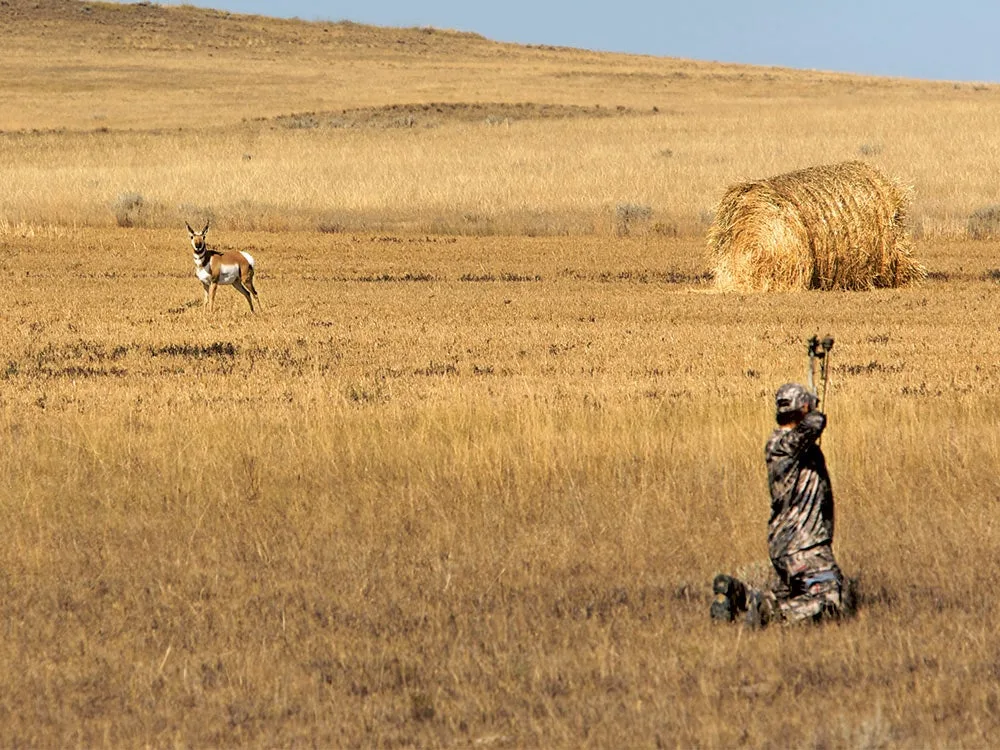Slipping up to the crest of the sage-flecked knoll, we peered down at a pair of stunning tan-and-white pronghorns. “What a buck,” I said, eyeing the closer one. “He’ll go close to 15 inches.”
“Yep,” my guide replied. “Now, if he’ll move a bit, we’ll get a better look at the real trophy behind him.” Making a classic novice’s mistake, I had assumed the taller buck closest to us was superior.
No sight is more emblematic of Western hunting than a pronghorn buck with jet-black horns staring back at you, poised to prance across the prairie at 70 mph. But just how good of a trophy is he? How thick and impressive will those horns be when you wrap your hands around them? Pronghorns are notoriously difficult to judge in the field. So I spoke to three veteran guides who have a century of analyzing antelope horns among them: Bill Ferranti of New Mexico, Bob Daugherty of Colorado, and Pete Dube of Wyoming.

How to Judge Pronghorn: The Three Keys
1. Horn Length
Most hunters focus on this. A 12-inch antelope is average; 13, good; 14, exceptional. Record-book pronghorns often tape 15 to 16 inches. But horns that jut straight up appear longer than they really are, while those curling back and inward, or with ivory tips, appear shorter.
The Solution: Try to view the buck from multiple angles so you can add the curl of the horn tips to your length estimate.
Tip: Use the distance between the tip of the animal’s nose and its eye (about 8 inches) or between its ears (12 inches) as a guide to horn length. Also look for a buck whose prongs protrude from the horn an inch or more above its ears.
2. Prongs
These are measured from the tip of the prong, along its upper edge, then across to the back center of the horn: 3 to 4 inches is average; 4 to 5, good; 5 to 6, excellent; and 6 to 7, record book. What protrudes from the horn is only part of the measurement. You need to figure out how many more inches you gain across the horn to its back axis.
The solution: Judge how much prong actually protrudes from the horn and then add about 2 inches for the width of the horn itself. A prong that extends 3 inches is excellent once you add those couple of inches.
Tip: Use the length of the ear, about 6 inches, for comparison. If the full prong measurement is almost that long, it’s a keeper.
3. Mass
This is the most critical factor of all, because it’s measured four times after dividing each horn length into quarters. Good mass tends to make horn length and prongs seem shorter than they really are. Circumference is difficult to judge, even for veteran antelope hunters. Complicating things, some animals have partially flattened bases, making them score lower than antelope with more rounded bases. Basal circumference on outstanding bucks will measure 6 to 7 inches.
The Solution: Study videos and books or visit a taxidermy shop to learn the art of judging mass. When you’re hunting, wait until the animal turns sideways to check whether the bases are round or flattened before making a circumference estimate.
Tip: Use an antelope’s eye circumference for comparison: It’s about 41⁄2 inches. Also look at the diameter of the eye, about 11⁄2 inches across. If the antelope’s bases look about an inch wider than the eye width, they’ll likely measure over 7 inches—now that’s a pronghorn.





